Quiz-summary
0 of 73 questions completed
Questions:
- 1
- 2
- 3
- 4
- 5
- 6
- 7
- 8
- 9
- 10
- 11
- 12
- 13
- 14
- 15
- 16
- 17
- 18
- 19
- 20
- 21
- 22
- 23
- 24
- 25
- 26
- 27
- 28
- 29
- 30
- 31
- 32
- 33
- 34
- 35
- 36
- 37
- 38
- 39
- 40
- 41
- 42
- 43
- 44
- 45
- 46
- 47
- 48
- 49
- 50
- 51
- 52
- 53
- 54
- 55
- 56
- 57
- 58
- 59
- 60
- 61
- 62
- 63
- 64
- 65
- 66
- 67
- 68
- 69
- 70
- 71
- 72
- 73
Information
Road & Traffic Sign Part 2
You have already completed the quiz before. Hence you can not start it again.
Quiz is loading...
You must sign in or sign up to start the quiz.
You have to finish following quiz, to start this quiz:
Results
0 of 73 questions answered correctly
Your time:
Time has elapsed
You have reached 0 of 0 points, (0)
Categories
- Not categorized 0%
- 1
- 2
- 3
- 4
- 5
- 6
- 7
- 8
- 9
- 10
- 11
- 12
- 13
- 14
- 15
- 16
- 17
- 18
- 19
- 20
- 21
- 22
- 23
- 24
- 25
- 26
- 27
- 28
- 29
- 30
- 31
- 32
- 33
- 34
- 35
- 36
- 37
- 38
- 39
- 40
- 41
- 42
- 43
- 44
- 45
- 46
- 47
- 48
- 49
- 50
- 51
- 52
- 53
- 54
- 55
- 56
- 57
- 58
- 59
- 60
- 61
- 62
- 63
- 64
- 65
- 66
- 67
- 68
- 69
- 70
- 71
- 72
- 73
- Answered
- Review
-
Question 1 of 73
1. Question
You’re at a junction controlled by traffic lights. When shouldn’t you proceed at green?
 Correct
Correct
Official DVSA Explanation
As you approach the lights, look into the road you wish to take. Only proceed if your exit road is clear. If the road is blocked, hold back, even if you have to wait for the next green signal.
Incorrect
Official DVSA Explanation
As you approach the lights, look into the road you wish to take. Only proceed if your exit road is clear. If the road is blocked, hold back, even if you have to wait for the next green signal.
-
Question 2 of 73
2. Question
You’re in the left-hand lane at traffic lights, waiting to turn left. At which of these traffic lights mustn’t you move on?
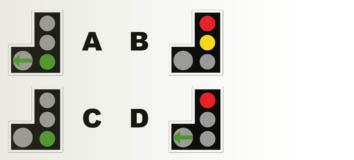 Correct
Correct
Official DVSA Explanation
At some junctions, there may be separate signals for different lanes. These are called ‘filter’ lights. They’re designed to help traffic flow at major junctions. Make sure that you’re in the correct lane and proceed if the way is clear and the green light shows for your lane.
Incorrect
Official DVSA Explanation
At some junctions, there may be separate signals for different lanes. These are called ‘filter’ lights. They’re designed to help traffic flow at major junctions. Make sure that you’re in the correct lane and proceed if the way is clear and the green light shows for your lane.
-
Question 3 of 73
3. Question
What does this sign mean?
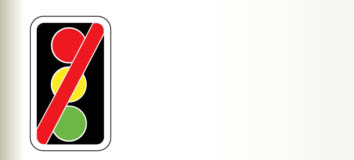 Correct
Correct
Official DVSA Explanation
You might see this sign where traffic lights are out of order. Proceed with caution, as nobody has priority at the junction.
Incorrect
Official DVSA Explanation
You might see this sign where traffic lights are out of order. Proceed with caution, as nobody has priority at the junction.
-
Question 4 of 73
4. Question
When traffic lights are out of order, who has priority?
Correct
Official DVSA Explanation
*When traffic lights are out of order, you should treat the junction as an unmarked crossroads. Be cautious, as you may need to give way or stop. Look for traffic attempting to cross the junction, unaware that it doesn’t have priority.
Incorrect
Official DVSA Explanation
*When traffic lights are out of order, you should treat the junction as an unmarked crossroads. Be cautious, as you may need to give way or stop. Look for traffic attempting to cross the junction, unaware that it doesn’t have priority.
-
Question 5 of 73
5. Question
These flashing red lights mean that you must stop. Where would you find them?
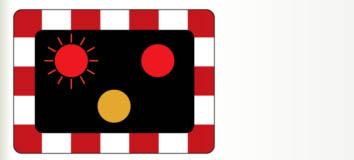 Correct
Correct
Official DVSA Explanation
These signals are found at level crossings, swing or lifting bridges, some airfields and emergency access sites. The flashing red lights mean stop whether or not the way seems to be clear.
Incorrect
Official DVSA Explanation
These signals are found at level crossings, swing or lifting bridges, some airfields and emergency access sites. The flashing red lights mean stop whether or not the way seems to be clear.
-
Question 6 of 73
6. Question
What do these zigzag lines at pedestrian crossings mean?
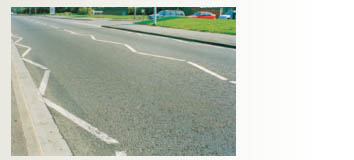 Correct
Correct
Official DVSA Explanation
The approach to, and exit from, a pedestrian crossing is marked with zigzag lines. You mustn’t park on them or overtake the leading vehicle when approaching the crossing. Parking here would block the view for pedestrians and approaching traffic.
Incorrect
Official DVSA Explanation
The approach to, and exit from, a pedestrian crossing is marked with zigzag lines. You mustn’t park on them or overtake the leading vehicle when approaching the crossing. Parking here would block the view for pedestrians and approaching traffic.
-
Question 7 of 73
7. Question
When may you cross a double solid white line in the middle of the road?
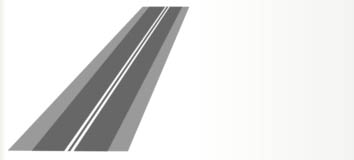 Correct
Correct
Official DVSA Explanation
You may cross the solid white line to pass a stationary vehicle or to pass a pedal cycle, horse or road maintenance vehicle if it’s travelling at 10 mph or less. You may also cross the solid white line to enter a side road or access a property.
Incorrect
Official DVSA Explanation
You may cross the solid white line to pass a stationary vehicle or to pass a pedal cycle, horse or road maintenance vehicle if it’s travelling at 10 mph or less. You may also cross the solid white line to enter a side road or access a property.
-
Question 8 of 73
8. Question
What does this road marking mean?
 Correct
Correct
Official DVSA Explanation
Road markings will warn you of a hazard ahead. A single broken line along the centre of the road, with long markings and short gaps, is a hazard warning line. Don’t cross it unless you can see that the road is clear well ahead.
Incorrect
Official DVSA Explanation
Road markings will warn you of a hazard ahead. A single broken line along the centre of the road, with long markings and short gaps, is a hazard warning line. Don’t cross it unless you can see that the road is clear well ahead.
-
Question 9 of 73
9. Question
Where would you see this road marking?
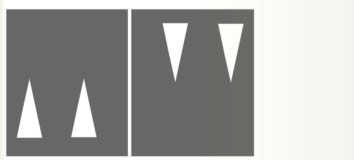 Correct
Correct
Official DVSA Explanation
Because the road has a dark colour, changes in level aren’t easily seen. White triangles painted on the road surface give you an indication of where there are road humps.
Incorrect
Official DVSA Explanation
Because the road has a dark colour, changes in level aren’t easily seen. White triangles painted on the road surface give you an indication of where there are road humps.
-
Question 10 of 73
10. Question
Which of these is a hazard warning line?
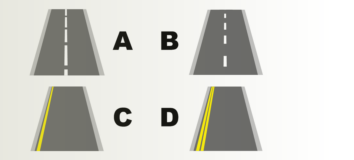 Correct
Correct
Official DVSA Explanation
You need to know the difference between the normal centre line and a hazard warning line. If there’s a hazard ahead, the markings are longer and the gaps shorter. This gives you advance warning of an unspecified hazard.
Incorrect
Official DVSA Explanation
You need to know the difference between the normal centre line and a hazard warning line. If there’s a hazard ahead, the markings are longer and the gaps shorter. This gives you advance warning of an unspecified hazard.
-
Question 11 of 73
11. Question
At this junction, there’s a ‘stop’ sign and a solid white line on the road surface. Why is there a ‘stop’ sign here?
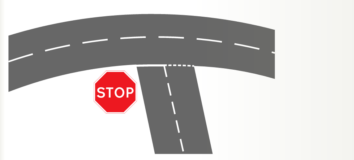 Correct
Correct
Official DVSA Explanation
If your view at a road junction is restricted, you must stop. There may also be a ‘stop’ sign. Don’t emerge until you’re sure no traffic is approaching. If you don’t know, don’t go.
Incorrect
Official DVSA Explanation
If your view at a road junction is restricted, you must stop. There may also be a ‘stop’ sign. Don’t emerge until you’re sure no traffic is approaching. If you don’t know, don’t go.
-
Question 12 of 73
12. Question
You see this line across the road at the entrance to a roundabout. What does it mean?
 Correct
Correct
Official DVSA Explanation
Slow down as you approach the roundabout and check for traffic from the right. If you need to stop and give way, stay behind the broken line until it’s safe to emerge onto the roundabout.
Incorrect
Official DVSA Explanation
Slow down as you approach the roundabout and check for traffic from the right. If you need to stop and give way, stay behind the broken line until it’s safe to emerge onto the roundabout.
-
Question 13 of 73
13. Question
How will a police officer in a patrol vehicle normally get you to stop?
Correct
Official DVSA Explanation
*You must obey signals given by the police. If a police officer in a patrol vehicle wants you to pull over, they’ll indicate this without causing danger to you or other traffic.
Incorrect
Official DVSA Explanation
*You must obey signals given by the police. If a police officer in a patrol vehicle wants you to pull over, they’ll indicate this without causing danger to you or other traffic.
-
Question 14 of 73
14. Question
You’re approaching a junction where the traffic lights aren’t working. What should you do when a police officer gives this signal?
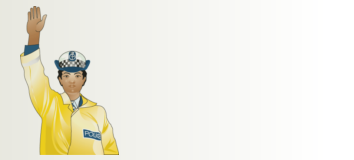 Correct
Correct
Official DVSA Explanation
When a police officer or traffic warden is directing traffic, you must obey them. They’ll use the arm signals shown in The Highway Code. Learn what these signals mean and obey them.
Incorrect
Official DVSA Explanation
When a police officer or traffic warden is directing traffic, you must obey them. They’ll use the arm signals shown in The Highway Code. Learn what these signals mean and obey them.
-
Question 15 of 73
15. Question
The driver of the car in front is giving this arm signal. What does it mean?
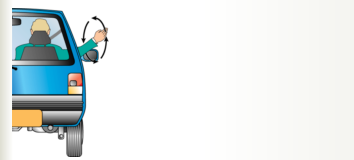 Correct
Correct
Official DVSA Explanation
There might be an occasion where another driver uses an arm signal. This may be because the vehicle’s indicators are obscured by other traffic. In order for such signals to be effective, all drivers should know their meaning. Be aware that the ‘left turn’ signal might look similar to the ‘slowing down’ signal.
Incorrect
Official DVSA Explanation
There might be an occasion where another driver uses an arm signal. This may be because the vehicle’s indicators are obscured by other traffic. In order for such signals to be effective, all drivers should know their meaning. Be aware that the ‘left turn’ signal might look similar to the ‘slowing down’ signal.
-
Question 16 of 73
16. Question
Where would you see these road markings?
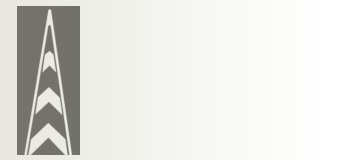 Correct
Correct
Official DVSA Explanation
When driving on a motorway or slip road, you mustn’t enter an area marked with chevrons and bordered by a solid white line for any reason, except in an emergency.
Incorrect
Official DVSA Explanation
When driving on a motorway or slip road, you mustn’t enter an area marked with chevrons and bordered by a solid white line for any reason, except in an emergency.
-
Question 17 of 73
17. Question
What does this motorway sign mean?
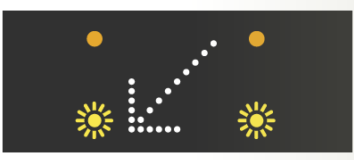 Correct
Correct
Official DVSA Explanation
On the motorway, signs sometimes show temporary warnings due to traffic or weather conditions. They may be used to indicate
• lane closures
• temporary speed limits
• weather warnings.
Incorrect
Official DVSA Explanation
On the motorway, signs sometimes show temporary warnings due to traffic or weather conditions. They may be used to indicate
• lane closures
• temporary speed limits
• weather warnings.
-
Question 18 of 73
18. Question
What does this motorway sign mean?
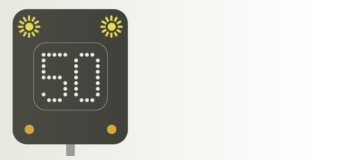 Correct
Correct
Official DVSA Explanation
Look out for signs above your lane or on the central reservation. These will give you important information or warnings about the road ahead. To allow for the high speed of motorway traffic, these signs may light up some distance from any hazard. Don’t ignore the signs just because the road looks clear to you.
Incorrect
Official DVSA Explanation
Look out for signs above your lane or on the central reservation. These will give you important information or warnings about the road ahead. To allow for the high speed of motorway traffic, these signs may light up some distance from any hazard. Don’t ignore the signs just because the road looks clear to you.
-
Question 19 of 73
19. Question
What does this sign mean?
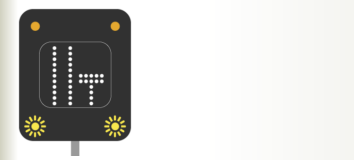 Correct
Correct
Official DVSA Explanation
You should change lanes as directed by the sign. Here, the right-hand lane is closed but the left-hand and centre lanes are available. Merging in turn is recommended when it’s safe and traffic is going slowly; for example, at roadworks or a road traffic incident. When vehicles are travelling at speed, this isn’t advisable and you should move into the appropriate lane in good time.
Incorrect
Official DVSA Explanation
You should change lanes as directed by the sign. Here, the right-hand lane is closed but the left-hand and centre lanes are available. Merging in turn is recommended when it’s safe and traffic is going slowly; for example, at roadworks or a road traffic incident. When vehicles are travelling at speed, this isn’t advisable and you should move into the appropriate lane in good time.
-
Question 20 of 73
20. Question
What does ‘25’ mean on this motorway sign?
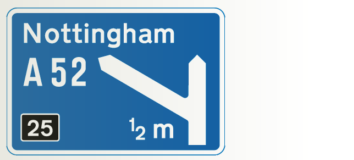 Correct
Correct
Official DVSA Explanation
Before you set out on your journey, use a road map to plan your route. When you see an advance warning of your junction, make sure you get into the correct lane in plenty of time. Last-minute harsh braking and cutting across lanes at speed is extremely hazardous.
Incorrect
Official DVSA Explanation
Before you set out on your journey, use a road map to plan your route. When you see an advance warning of your junction, make sure you get into the correct lane in plenty of time. Last-minute harsh braking and cutting across lanes at speed is extremely hazardous.
-
Question 21 of 73
21. Question
How should the right-hand lane of a three-lane motorway be used?
Correct
Official DVSA Explanation
*You should stay in the left-hand lane of a motorway unless you’re overtaking another vehicle. The right-hand lane of a motorway is an overtaking lane; it isn’t the ‘fast lane’. After overtaking, move back to the left when it’s safe to do so.
Incorrect
Official DVSA Explanation
*You should stay in the left-hand lane of a motorway unless you’re overtaking another vehicle. The right-hand lane of a motorway is an overtaking lane; it isn’t the ‘fast lane’. After overtaking, move back to the left when it’s safe to do so.
-
Question 22 of 73
22. Question
Where can you find reflective amber studs on a motorway?
Correct
Official DVSA Explanation
*At night or in poor visibility, reflective studs on the road help you to judge your position on the carriageway.
Incorrect
Official DVSA Explanation
*At night or in poor visibility, reflective studs on the road help you to judge your position on the carriageway.
-
Question 23 of 73
23. Question
Where on a motorway would you find green reflective studs?
Correct
Official DVSA Explanation
*Knowing the colours of the reflective studs on the road will help you judge your position, especially at night, in foggy conditions or when visibility is poor.
Incorrect
Official DVSA Explanation
*Knowing the colours of the reflective studs on the road will help you judge your position, especially at night, in foggy conditions or when visibility is poor.
-
Question 24 of 73
24. Question
What should you do when you see this sign as you travel along a motorway?
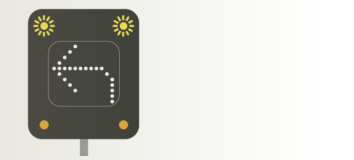 Correct
Correct
Official DVSA Explanation
You’ll see this sign if the motorway is closed ahead. Pull into the left-hand lane as soon as it’s safe to do so. Don’t wait until the last moment before you move across, because the lane may be busy and you’ll have to rely on another driver making room for you.ol.
Incorrect
Official DVSA Explanation
You’ll see this sign if the motorway is closed ahead. Pull into the left-hand lane as soon as it’s safe to do so. Don’t wait until the last moment before you move across, because the lane may be busy and you’ll have to rely on another driver making room for you.ol.
-
Question 25 of 73
25. Question
What does this sign mean?
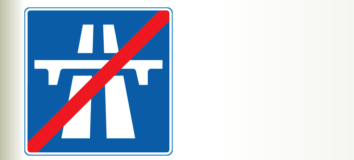 Correct
Correct
Official DVSA Explanation
When you leave the motorway, make sure that you check your speedometer. You may be going faster than you realise. Slow down and look for speed-limit signs.
Incorrect
Official DVSA Explanation
When you leave the motorway, make sure that you check your speedometer. You may be going faster than you realise. Slow down and look for speed-limit signs.
-
Question 26 of 73
26. Question
Which of these signs means that the national speed limit applies?
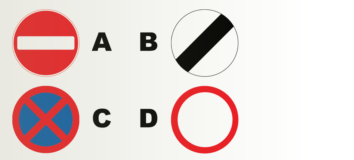 Correct
Correct
Official DVSA Explanation
You should know the speed limit for the road on which you’re travelling and the vehicle that you’re driving. The different speed limits are shown in The Highway Code.
Incorrect
Official DVSA Explanation
You should know the speed limit for the road on which you’re travelling and the vehicle that you’re driving. The different speed limits are shown in The Highway Code.
-
Question 27 of 73
27. Question
What’s the maximum speed on a single carriageway road?
Correct
Official DVSA Explanation
*If you’re travelling on a dual carriageway that becomes a single carriageway road, reduce your speed gradually so that you aren’t exceeding the limit as you enter. There might not be a sign to remind you of the limit, so make sure you know the speed limits for different types of road and vehicle.
Incorrect
Official DVSA Explanation
*If you’re travelling on a dual carriageway that becomes a single carriageway road, reduce your speed gradually so that you aren’t exceeding the limit as you enter. There might not be a sign to remind you of the limit, so make sure you know the speed limits for different types of road and vehicle.
-
Question 28 of 73
28. Question
What does this sign mean?
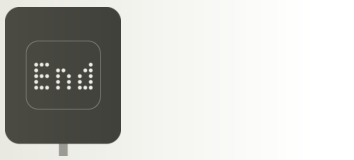 Correct
Correct
Official DVSA Explanation
Temporary restrictions on motorways are shown on signs that have flashing amber lights. At the end of the restriction, you’ll see this sign without any flashing lights.
Incorrect
Official DVSA Explanation
Temporary restrictions on motorways are shown on signs that have flashing amber lights. At the end of the restriction, you’ll see this sign without any flashing lights.
-
Question 29 of 73
29. Question
What does this sign indicate?
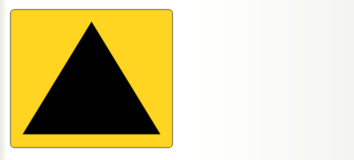 Correct
Correct
Official DVSA Explanation
When a diversion route has been put in place, drivers are advised to follow a symbol, which may be a black triangle, square, circle or diamond shape on a yellow background.
Incorrect
Official DVSA Explanation
When a diversion route has been put in place, drivers are advised to follow a symbol, which may be a black triangle, square, circle or diamond shape on a yellow background.
-
Question 30 of 73
30. Question
What does this temporary sign indicate?
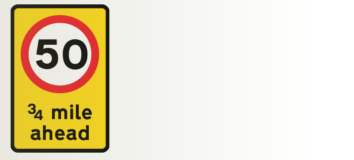 Correct
Correct
Official DVSA Explanation
In the interests of road safety, temporary mandatory speed limits are imposed at all major roadworks. Signs like this, giving advance warning of the speed limit, are normally placed about three-quarters of a mile ahead of where the speed limit comes into force.
Incorrect
Official DVSA Explanation
In the interests of road safety, temporary mandatory speed limits are imposed at all major roadworks. Signs like this, giving advance warning of the speed limit, are normally placed about three-quarters of a mile ahead of where the speed limit comes into force.
-
Question 31 of 73
31. Question
What does this traffic sign mean?
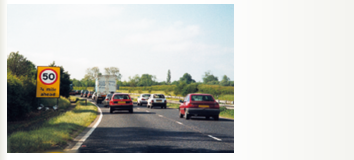 Correct
Correct
Official DVSA Explanation
The sign gives you an early warning of a speed restriction. If you’re travelling at a higher speed, slow down in good time. You could come across queuing traffic due to roadworks or a temporary obstruction.
Incorrect
Official DVSA Explanation
The sign gives you an early warning of a speed restriction. If you’re travelling at a higher speed, slow down in good time. You could come across queuing traffic due to roadworks or a temporary obstruction.
-
Question 32 of 73
32. Question
What should you do when you see this sign at a crossroads?
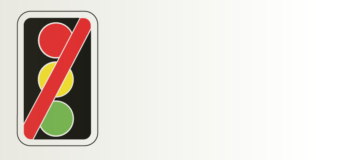 Correct
Correct
Official DVSA Explanation
When traffic lights are out of order, treat the junction as an unmarked crossroads. Be very careful and be prepared to stop; no-one has priority.
Incorrect
Official DVSA Explanation
When traffic lights are out of order, treat the junction as an unmarked crossroads. Be very careful and be prepared to stop; no-one has priority.
-
Question 33 of 73
33. Question
You’re signalling to turn right in busy traffic. How would you confirm your intention safely?
Correct
Official DVSA Explanation
*In some situations, you may feel your indicators can’t be seen by other road users. If you think you need to make your intention more obvious, give the arm signal shown in The Highway Code.
Incorrect
Official DVSA Explanation
*In some situations, you may feel your indicators can’t be seen by other road users. If you think you need to make your intention more obvious, give the arm signal shown in The Highway Code.
-
Question 34 of 73
34. Question
What does this sign mean?
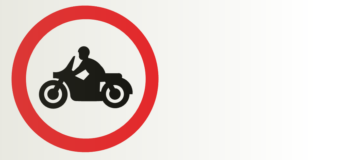 Correct
Correct
Official DVSA Explanation
You must comply with all traffic signs and be especially aware of those signs that apply specifically to the type of vehicle you’re using.
Incorrect
Official DVSA Explanation
You must comply with all traffic signs and be especially aware of those signs that apply specifically to the type of vehicle you’re using.
-
Question 35 of 73
35. Question
You’re on a motorway. A lorry has stopped in the right-hand lane. What should you do when you see this sign on the lorry?
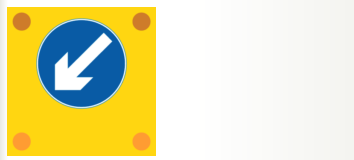 Correct
Correct
Official DVSA Explanation
Sometimes work is carried out on the motorway without closing the lanes. When this happens, signs are mounted on the back of lorries to warn other road users of the roadworks ahead.
Incorrect
Official DVSA Explanation
Sometimes work is carried out on the motorway without closing the lanes. When this happens, signs are mounted on the back of lorries to warn other road users of the roadworks ahead.
-
Question 36 of 73
36. Question
You’re on a motorway. Red flashing lights appear above your lane only. What should you do?
Correct
Official DVSA Explanation
*Flashing red lights above your lane show that your lane is closed. You should move into another lane as soon as you can do so safely.
Incorrect
Official DVSA Explanation
*Flashing red lights above your lane show that your lane is closed. You should move into another lane as soon as you can do so safely.
-
Question 37 of 73
37. Question
When may you sound the horn?
Correct
Official DVSA Explanation
*Never sound the horn aggressively. You mustn’t sound it when driving in a built-up area between 11.30 pm and 7.00 am, or when you’re stationary, unless another road user poses a danger. Don’t scare animals by sounding your horn.
Incorrect
Official DVSA Explanation
*Never sound the horn aggressively. You mustn’t sound it when driving in a built-up area between 11.30 pm and 7.00 am, or when you’re stationary, unless another road user poses a danger. Don’t scare animals by sounding your horn.
-
Question 38 of 73
38. Question
Your vehicle is stationary. When may you use its horn?
Correct
Official DVSA Explanation
*When your vehicle is stationary, only sound the horn if you think there’s a risk of danger from another road user. Don’t use it just to attract someone’s attention. This causes unnecessary noise and could be misleading.
Incorrect
Official DVSA Explanation
*When your vehicle is stationary, only sound the horn if you think there’s a risk of danger from another road user. Don’t use it just to attract someone’s attention. This causes unnecessary noise and could be misleading.
-
Question 39 of 73
39. Question
What does this sign mean?
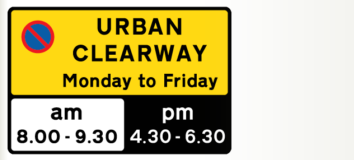 Correct
Correct
Official DVSA Explanation
Urban clearways are provided to keep traffic flowing at busy times. You may stop only briefly to set down or pick up passengers. Times of operation will vary from place to place, so always check the signs.
Incorrect
Official DVSA Explanation
Urban clearways are provided to keep traffic flowing at busy times. You may stop only briefly to set down or pick up passengers. Times of operation will vary from place to place, so always check the signs.
-
Question 40 of 73
40. Question
What does this sign mean?
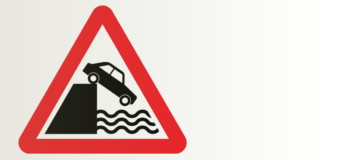 Correct
Correct
Official DVSA Explanation
You should be careful in these locations, as the road surface is likely to be wet and slippery. There may be a steep drop to the water, and there may not be a barrier along the edge of the road.
Incorrect
Official DVSA Explanation
You should be careful in these locations, as the road surface is likely to be wet and slippery. There may be a steep drop to the water, and there may not be a barrier along the edge of the road.
-
Question 41 of 73
41. Question
Which sign means you have priority over oncoming vehicles?
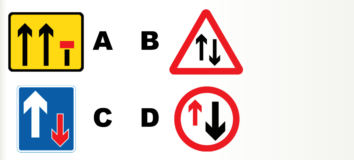 Correct
Correct
Official DVSA Explanation
Even though you have priority, be prepared to give way if other drivers don’t. This will help to avoid congestion, confrontation or even a collision.
Incorrect
Official DVSA Explanation
Even though you have priority, be prepared to give way if other drivers don’t. This will help to avoid congestion, confrontation or even a collision.
-
Question 42 of 73
42. Question
What does this white line along the centre of the road mean?
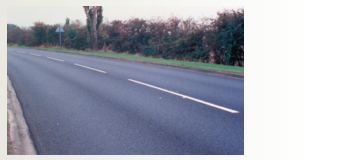 Correct
Correct
Official DVSA Explanation
The centre of the road is usually marked by a broken white line, with lines that are shorter than the gaps. When the lines become longer than the gaps, this is a hazard warning line. Look well ahead for these, especially when you’re planning to overtake or turn off.
Incorrect
Official DVSA Explanation
The centre of the road is usually marked by a broken white line, with lines that are shorter than the gaps. When the lines become longer than the gaps, this is a hazard warning line. Look well ahead for these, especially when you’re planning to overtake or turn off.
-
Question 43 of 73
43. Question
What’s the reason for the yellow criss-cross lines painted on the road here?
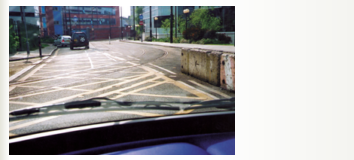 Correct
Correct
Official DVSA Explanation
Yellow ‘box junctions’ like this are often used where it’s busy. Their purpose is to keep the junction clear for crossing traffic. Don’t enter the painted area unless your exit is clear. The one exception is when you’re turning right and are only prevented from doing so by oncoming traffic or by other vehicles waiting to turn right.
Incorrect
Official DVSA Explanation
Yellow ‘box junctions’ like this are often used where it’s busy. Their purpose is to keep the junction clear for crossing traffic. Don’t enter the painted area unless your exit is clear. The one exception is when you’re turning right and are only prevented from doing so by oncoming traffic or by other vehicles waiting to turn right.
-
Question 44 of 73
44. Question
What’s the reason for the area marked in red and white along the centre of this road?
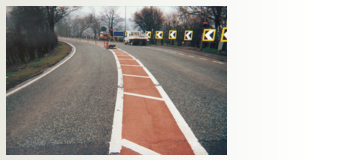 Correct
Correct
Official DVSA Explanation
Areas of ‘hatched markings’ such as these separate traffic streams that could be a danger to each other. They’re often seen on bends or where the road becomes narrow. If the area is bordered by a solid white line, you mustn’t enter it except in an emergency.
Incorrect
Official DVSA Explanation
Areas of ‘hatched markings’ such as these separate traffic streams that could be a danger to each other. They’re often seen on bends or where the road becomes narrow. If the area is bordered by a solid white line, you mustn’t enter it except in an emergency.
-
Question 45 of 73
45. Question
Other drivers may sometimes flash their headlights at you. In which situation are they allowed to do this?
Correct
Official DVSA Explanation
*If other drivers flash their headlights, this isn’t a signal to show priority. The flashing of headlights has the same meaning as sounding the horn: it’s a warning of their presence.
Incorrect
Official DVSA Explanation
*If other drivers flash their headlights, this isn’t a signal to show priority. The flashing of headlights has the same meaning as sounding the horn: it’s a warning of their presence.
-
Question 46 of 73
46. Question
What speed limit is often found in narrow residential streets?
Correct
Official DVSA Explanation
*In some built-up areas, you may find the speed limit reduced to 20 mph. Driving at a slower speed will help give you the time and space to see and deal safely with hazards such as pedestrians and other vulnerable road users.
Incorrect
Official DVSA Explanation
*In some built-up areas, you may find the speed limit reduced to 20 mph. Driving at a slower speed will help give you the time and space to see and deal safely with hazards such as pedestrians and other vulnerable road users.
-
Question 47 of 73
47. Question
What does this signal mean?
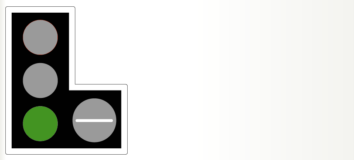 Correct
Correct
Official DVSA Explanation
The white light shows that trams must stop. The green light shows that other vehicles can go if the way is clear. Trams are being introduced into more cities, so you’re likely to come across them and you should learn which signs apply to them.
Incorrect
Official DVSA Explanation
The white light shows that trams must stop. The green light shows that other vehicles can go if the way is clear. Trams are being introduced into more cities, so you’re likely to come across them and you should learn which signs apply to them.
-
Question 48 of 73
48. Question
Where would you find these road markings?
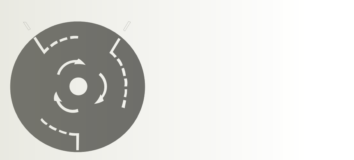 Correct
Correct
Official DVSA Explanation
These markings show the direction in which the traffic should go at a mini-roundabout.
Incorrect
Official DVSA Explanation
These markings show the direction in which the traffic should go at a mini-roundabout.
-
Question 49 of 73
49. Question
A police car is following you. The police officer flashes the headlights and points to the left. What should you do?
Correct
Official DVSA Explanation
*You must pull up on the left as soon as it’s safe to do so and switch off your engine.
Incorrect
Official DVSA Explanation
*You must pull up on the left as soon as it’s safe to do so and switch off your engine.
-
Question 50 of 73
50. Question
You see this amber traffic light ahead. Which light, or lights, will come on next?
Correct
Official DVSA Explanation
At junctions controlled by traffic lights, you must stop behind the white line until the lights change to green. A red light, an amber light, and red and amber lights showing together all mean stop.
You may proceed when the light is green unless your exit road is blocked or pedestrians are crossing in front of you.
If you’re approaching traffic lights that are visible from a distance and the light has been green for some time, be ready to slow down and stop, because the lights are likely to change.
Incorrect
Official DVSA Explanation
At junctions controlled by traffic lights, you must stop behind the white line until the lights change to green. A red light, an amber light, and red and amber lights showing together all mean stop.
You may proceed when the light is green unless your exit road is blocked or pedestrians are crossing in front of you.
If you’re approaching traffic lights that are visible from a distance and the light has been green for some time, be ready to slow down and stop, because the lights are likely to change.
-
Question 51 of 73
51. Question
You see this signal overhead on the motorway. What does it mean?
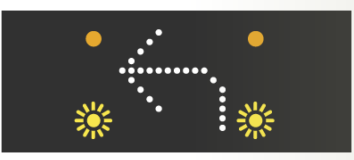 Correct
Correct
Official DVSA Explanation
You’ll see this sign if there has been an incident ahead and the motorway is closed. You must obey the sign. Make sure that you prepare to leave in good time.
Don’t cause drivers to take avoiding action by cutting in at the last moment.
Incorrect
Official DVSA Explanation
You’ll see this sign if there has been an incident ahead and the motorway is closed. You must obey the sign. Make sure that you prepare to leave in good time.
Don’t cause drivers to take avoiding action by cutting in at the last moment.
-
Question 52 of 73
52. Question
What must you do when you see this sign?
 Correct
Correct
Official DVSA Explanation
‘Stop’ signs are situated at junctions where visibility is restricted or where there’s heavy traffic. They must be obeyed: you must stop.
Take good all-round observation before moving off.
Incorrect
Official DVSA Explanation
‘Stop’ signs are situated at junctions where visibility is restricted or where there’s heavy traffic. They must be obeyed: you must stop.
Take good all-round observation before moving off.
-
Question 53 of 73
53. Question
Which shape is used for a ‘give way’ sign?
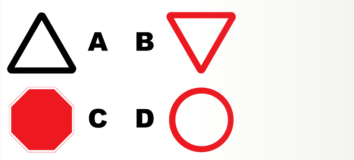 Correct
Correct
Official DVSA Explanation
Other warning signs are the same shape and colour, but the ‘give way’ triangle points downwards. When you see this sign, you must give way to traffic on the road that you’re about to enter.
Incorrect
Official DVSA Explanation
Other warning signs are the same shape and colour, but the ‘give way’ triangle points downwards. When you see this sign, you must give way to traffic on the road that you’re about to enter.
-
Question 54 of 73
54. Question
What does this sign mean?
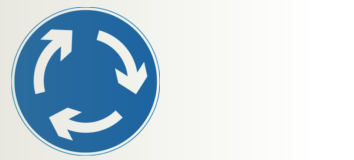 Correct
Correct
Official DVSA Explanation
When you see this sign, look out for any direction signs and judge whether you need to signal your intentions. Do this in good time so that other road users approaching the roundabout know what you’re planning to do.
Incorrect
Official DVSA Explanation
When you see this sign, look out for any direction signs and judge whether you need to signal your intentions. Do this in good time so that other road users approaching the roundabout know what you’re planning to do.
-
Question 55 of 73
55. Question
What does this sign mean?
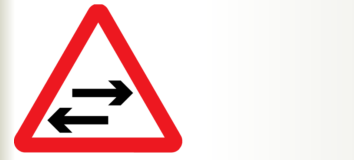 Correct
Correct
Official DVSA Explanation
Be prepared for traffic approaching from junctions on either side of you. Try to avoid unnecessary changing of lanes just before the junction.
Incorrect
Official DVSA Explanation
Be prepared for traffic approaching from junctions on either side of you. Try to avoid unnecessary changing of lanes just before the junction.
-
Question 56 of 73
56. Question
What does this sign mean?
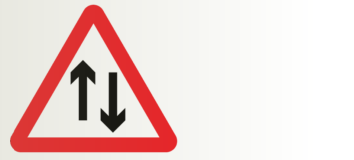 Correct
Correct
Official DVSA Explanation
This sign may be at the end of a dual carriageway or a one-way street. It’s there to warn you of oncoming traffic.
Incorrect
Official DVSA Explanation
This sign may be at the end of a dual carriageway or a one-way street. It’s there to warn you of oncoming traffic.
-
Question 57 of 73
57. Question
What does this sign mean?
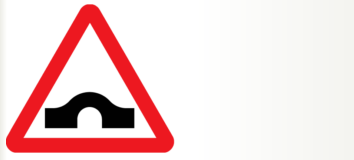 Correct
Correct
Official DVSA Explanation
You’ll need to slow down. At hump bridges, your view ahead will be restricted and the road will often be narrow. If the bridge is very steep, sound your horn to warn others of your approach. Going over the bridge too fast is highly dangerous to other road users and could even cause your wheels to leave the road, with a resulting loss of control.
Incorrect
Official DVSA Explanation
You’ll need to slow down. At hump bridges, your view ahead will be restricted and the road will often be narrow. If the bridge is very steep, sound your horn to warn others of your approach. Going over the bridge too fast is highly dangerous to other road users and could even cause your wheels to leave the road, with a resulting loss of control.
-
Question 58 of 73
58. Question
Which sign informs you that you’re coming to a ‘no through road’?
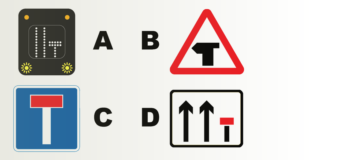 Correct
Correct
Official DVSA Explanation
This sign is found at the entrance to a road that can only be used for access.
Incorrect
Official DVSA Explanation
This sign is found at the entrance to a road that can only be used for access.
-
Question 59 of 73
59. Question
What does this sign mean?
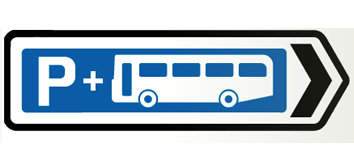 Correct
Correct
Official DVSA Explanation
To ease the congestion in town centres, some cities and towns provide park-and-ride schemes. These allow you to park in a designated area and ride by bus into the centre.
Park-and-ride schemes are usually cheaper and easier than car parking in the town centre.
Incorrect
Official DVSA Explanation
To ease the congestion in town centres, some cities and towns provide park-and-ride schemes. These allow you to park in a designated area and ride by bus into the centre.
Park-and-ride schemes are usually cheaper and easier than car parking in the town centre.
-
Question 60 of 73
60. Question
What should you do when approaching traffic lights where red and amber are showing together?
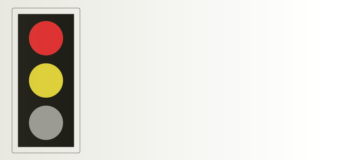 Correct
Correct
Official DVSA Explanation
Be aware that other traffic might still be clearing the junction as you approach. A green light means you may go on, but only if the way is clear.
Incorrect
Official DVSA Explanation
Be aware that other traffic might still be clearing the junction as you approach. A green light means you may go on, but only if the way is clear.
-
Question 61 of 73
61. Question
Where does this marking normally appear on a road?
 Correct
Correct
Official DVSA Explanation
This road marking means you should give way to traffic on the main road. It might not be used at junctions where there isn’t much traffic. However, if there’s a double broken line across the junction, the ‘give way’ rules still apply.
Incorrect
Official DVSA Explanation
This road marking means you should give way to traffic on the main road. It might not be used at junctions where there isn’t much traffic. However, if there’s a double broken line across the junction, the ‘give way’ rules still apply.
-
Question 62 of 73
62. Question
At a railway level crossing, the red lights continue to flash after a train has gone by. What should you do?
Correct
Official DVSA Explanation
*You must always obey red flashing stop lights. If a train passes but the lights continue to flash, another train will be passing soon. Cross only when the lights go off and the barriers open.
Incorrect
Official DVSA Explanation
*You must always obey red flashing stop lights. If a train passes but the lights continue to flash, another train will be passing soon. Cross only when the lights go off and the barriers open.
-
Question 63 of 73
63. Question
You’re in a tunnel and you see this sign. What does it mean?
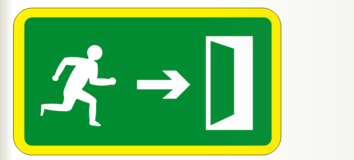 Correct
Correct
Official DVSA Explanation
If you have to leave your vehicle and get out of a tunnel by an emergency exit, do so as quickly as you can. Follow the signs directing you to the nearest exit point. If there are several people using the exit, don’t panic but try to leave in a calm and orderly manner.
Incorrect
Official DVSA Explanation
If you have to leave your vehicle and get out of a tunnel by an emergency exit, do so as quickly as you can. Follow the signs directing you to the nearest exit point. If there are several people using the exit, don’t panic but try to leave in a calm and orderly manner.
-
Question 64 of 73
64. Question
Which of these signs shows that you’re entering a one-way system?
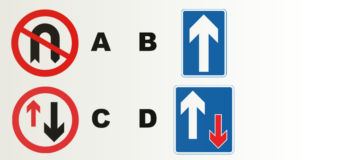 Correct
Correct
Official DVSA Explanation
If the road has two lanes, you can use either lane and overtake on either side. Use the lane that’s more convenient for your destination unless signs or road markings indicate otherwise.
Incorrect
Official DVSA Explanation
If the road has two lanes, you can use either lane and overtake on either side. Use the lane that’s more convenient for your destination unless signs or road markings indicate otherwise.
-
Question 65 of 73
65. Question
What does this sign mean?
 Correct
Correct
Official DVSA Explanation
Buses and cycles can travel in this lane. In this example, they’ll flow in the same direction as other traffic. If it’s busy, they may be passing you on the left, so watch out for them. Times on the sign will show the lane’s hours of operation; if no times are shown, or there’s no sign at all, this means the lane is in operation 24 hours a day. In some areas, other vehicles, such as taxis and motorcycles, are allowed to use bus lanes. The sign will show if this is the case.
Incorrect
Official DVSA Explanation
Buses and cycles can travel in this lane. In this example, they’ll flow in the same direction as other traffic. If it’s busy, they may be passing you on the left, so watch out for them. Times on the sign will show the lane’s hours of operation; if no times are shown, or there’s no sign at all, this means the lane is in operation 24 hours a day. In some areas, other vehicles, such as taxis and motorcycles, are allowed to use bus lanes. The sign will show if this is the case.
-
Question 66 of 73
66. Question
Which of these signs warns you of a zebra crossing?
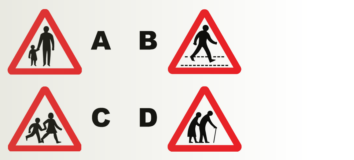 Correct
Correct
Official DVSA Explanation
Look well ahead and check the pavements and surrounding areas for pedestrians. Look for anyone walking towards the crossing. Check your mirrors for traffic behind, in case you have to slow down or stop.
Incorrect
Official DVSA Explanation
Look well ahead and check the pavements and surrounding areas for pedestrians. Look for anyone walking towards the crossing. Check your mirrors for traffic behind, in case you have to slow down or stop.
-
Question 67 of 73
67. Question
What does this sign mean?
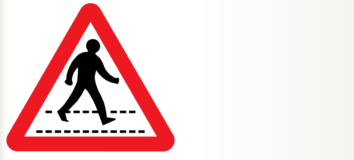 Correct
Correct
Official DVSA Explanation
Look well ahead and be ready to stop for any pedestrians crossing, or about to cross, the road. Also check the pavements for anyone who looks like they might step or run into the road.
Incorrect
Official DVSA Explanation
Look well ahead and be ready to stop for any pedestrians crossing, or about to cross, the road. Also check the pavements for anyone who looks like they might step or run into the road.
-
Question 68 of 73
68. Question
Which sign means there will be two-way traffic crossing your route ahead?
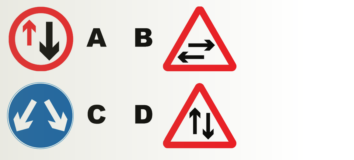 Correct
Correct
Official DVSA Explanation
This sign is found in or at the end of a one-way system. It warns you that traffic will be crossing your path from both directions.
Incorrect
Official DVSA Explanation
This sign is found in or at the end of a one-way system. It warns you that traffic will be crossing your path from both directions.
-
Question 69 of 73
69. Question
Which arm signal tells you that the car you’re following is going to pull up?
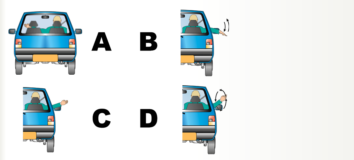 Correct
Correct
Official DVSA Explanation
There may be occasions when drivers need to give an arm signal to confirm their intentions. This could include in bright sunshine, at a complex road layout, when stopping at a pedestrian crossing or when turning right just after passing a parked vehicle. You should understand what each arm signal means. If you give arm signals, make them clear, correct and decisive.
Incorrect
Official DVSA Explanation
There may be occasions when drivers need to give an arm signal to confirm their intentions. This could include in bright sunshine, at a complex road layout, when stopping at a pedestrian crossing or when turning right just after passing a parked vehicle. You should understand what each arm signal means. If you give arm signals, make them clear, correct and decisive.
-
Question 70 of 73
70. Question
Which of these signs means turn left ahead?
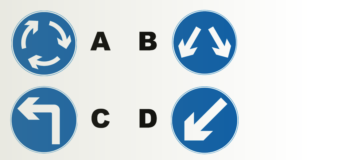 Correct
Correct
Official DVSA Explanation
Blue circles tell you what you must do and this sign gives a clear instruction to turn left ahead. You should be looking out for signs at all times and know what they mean.
Incorrect
Official DVSA Explanation
Blue circles tell you what you must do and this sign gives a clear instruction to turn left ahead. You should be looking out for signs at all times and know what they mean.
-
Question 71 of 73
71. Question
You’ve just driven past this sign. What should you be aware of?
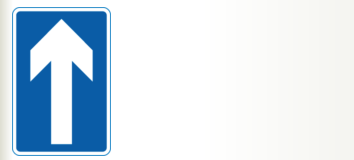 Correct
Correct
Official DVSA Explanation
In a one-way system, traffic may pass you on either side. Always be aware of all traffic signs and understand their meaning. Look well ahead and react to them in good time.
Incorrect
Official DVSA Explanation
In a one-way system, traffic may pass you on either side. Always be aware of all traffic signs and understand their meaning. Look well ahead and react to them in good time.
-
Question 72 of 73
72. Question
You’re approaching a red traffic light. What will the signal show next?
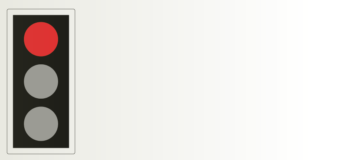 Correct
Correct
Official DVSA Explanation
If you know which light is going to show next, you can plan your approach accordingly. This can help prevent excessive braking or hesitation at the junction.
Incorrect
Official DVSA Explanation
If you know which light is going to show next, you can plan your approach accordingly. This can help prevent excessive braking or hesitation at the junction.
-
Question 73 of 73
73. Question
What does this sign mean?
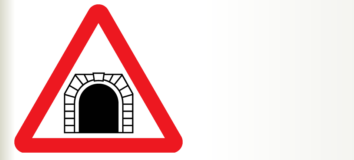 Correct
Correct
Official DVSA Explanation
When approaching a tunnel, switch on your dipped headlights. Be aware that your eyes might need to adjust to the sudden darkness. You may need to reduce your speed.
Incorrect
Official DVSA Explanation
When approaching a tunnel, switch on your dipped headlights. Be aware that your eyes might need to adjust to the sudden darkness. You may need to reduce your speed.
